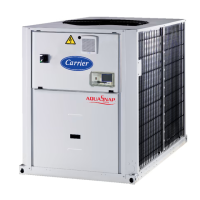Do you have a question about the Carrier 30RQS160 and is the answer not in the manual?
Crucial safety checks and precautions before unit installation and initial start-up.
Information on pressure equipment compliance, operating environment, and pressure considerations.
Guidelines for safe maintenance practices, logbook recommendations, and operational checks.
Safety protocols for unit repair, handling refrigerant, and potential risks like explosion.
Essential checks of the complete installation and refrigeration system before initial operation.
Details on connecting duct networks to the air heat exchanger and fan discharge for 30RQSY units.
Data on compressor usage, electrical characteristics, and circuit load information.
Defines the operating limits for cooling mode, including water and air temperatures.
Defines the operating limits for heating mode, including water and air temperatures.
Guidelines for connecting the power supply, voltage ranges, and warnings against improper supply.
Guidance on selecting appropriate wire sizes based on current, length, and installation standards.
Instructions for connecting field control wiring, including precautions and references to manuals.
Best practices for designing water circuits, including pipe runs, valves, and material compatibility.
Information on anti-cavitation protection for pumps, including minimum pressure requirements.
Procedures for cleaning the hydronic circuit and controlling water flow with fixed-speed pumps.
Controlling flow rate by maintaining a set pressure differential using variable-speed pumps.
Controlling flow rate by maintaining a set temperature difference using variable-speed pumps.
Essential pre-start checks for heat pump installation, including connections and leaks.
Procedures for supervised start-up and initial operational tests, referring to control manuals.
Configuration and operation of master/slave assemblies for coordinated unit control.
Installation and operational guidance for the desuperheater heat reclaim option.
Details on frost protection requirements for brine systems, including antifreeze concentration.
Semi-annual or annual checks requiring specific skills, covering electrical, mechanical, and water circuits.
Advanced maintenance operations requiring manufacturer or authorized agent intervention.












